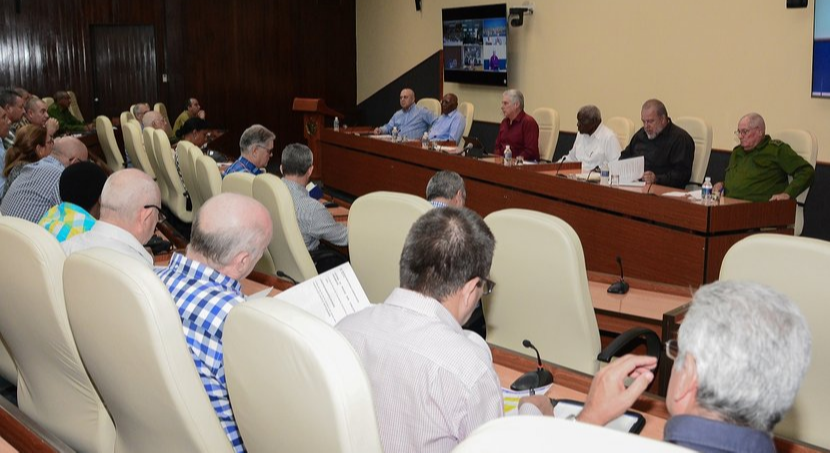
Ian recovery check-up meeting. Photo: Estudios Revolución
Havana, October 22 (RHC)-- At a meeting held Friday with the country's top leadership, headed by the President of the Republic of Cuba, Miguel Díaz-Canel Bermúdez, the progress of recovery work in each of the territories affected by Hurricane Ian was analyzed.
The provinces of Pinar del Río, Artemisa, Mayabeque and Havana, as well as the special municipality of Isla de la Juventud were the most affected territories after the passage of hurricane Ian through the west of the country on September 27.
According to the information provided from these territories by the main authorities of the Party and the Government, recovery is progressing favorably in all of them, although, logically, the complexity of the damages left by the impact of the meteorological phenomenon marks the pace of progress in the actions that are being carried out.
The issue of housing is the one that requires the most resources and time for its solution, hence the priority with which it was evaluated during the exchange. Consequently, it was learned that: in the special municipality of Isla de la Juventud, out of 404 houses affected, recovery actions have been completed in 137; in Mayabeque, 91 of the 368 damaged houses have been totally rehabilitated.
In Havana, 258 of the 1 176 houses affected during the meteorological event are now fully restored, and in Artemisa, the second province with the greatest damage, 814 of the 11 659 houses affected have been repaired.
A much deeper analysis, as usual, took place in Pinar del Río, a province where 107,093 houses suffered the ravages of Ian, of which 2,258 have been fully restored.
The president of the Provincial Defense Council, Yamilé Ramos Cordero, explained that 5 633 families have already purchased construction materials, a somewhat low figure considering that more than 26 000 forms have already been issued.
He also reported that, even though the municipalities have all the construction materials necessary to advance in the recovery actions, not all the materials are available at all the points of sale.
Regarding electricity service, he said that 66.76% of the customers have already been restored and the municipalities of San Juan y Martínez and San Luis continue to be the most complex, with only 28.9% and 30% of the energy restored, respectively.
As for the water supply, he pointed out that 145 of the 175 sources available in the province are working. Ninety-five pipes, he said, have been deployed in the territory to support these actions, one of the most complex currently faced by Pinar del Río.
Much work remains to be done in Pinar del Río to erase the traces left there by Ian. Vital in these difficult days has been the support provided by members of the Revolutionary Armed Forces who, according to Army Corps General Ramón Espinosa Martín, first deputy minister of the FAR appointed to lead the recovery work in that province, continue to work on the repair of social works and housing, the rehabilitation of affected electrical and road networks, as well as the collection and evacuation of debris.
The exchange was also headed by members of the Political Bureau, Esteban Lazo Hernández, president of the National Assembly; Roberto Morales Ojeda, secretary of Organization of the Party's Central Committee; Manuel Marrero Cruz, prime minister; Salvador Valdés Mesa, vice president of the Republic, and Army Corps General Álvaro López Miera, minister of the Revolutionary Armed Forces.

